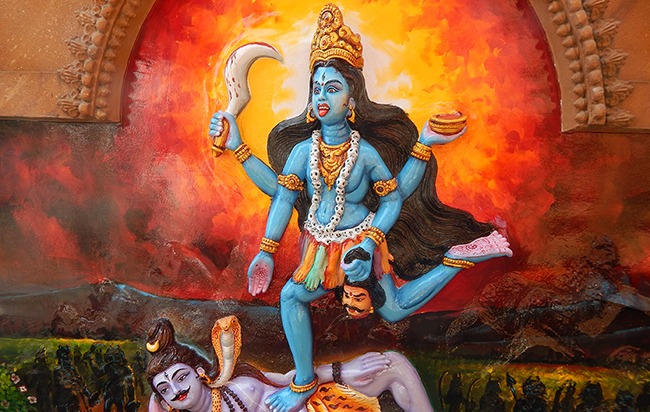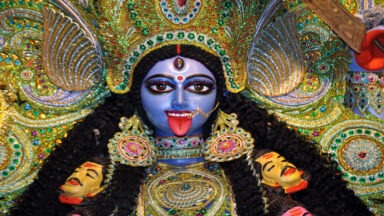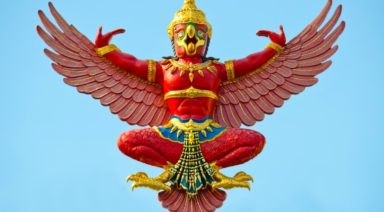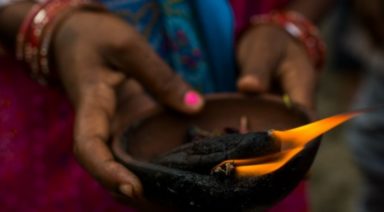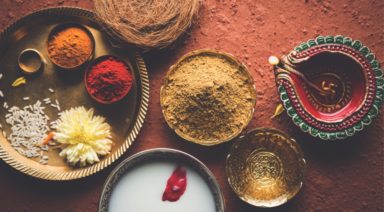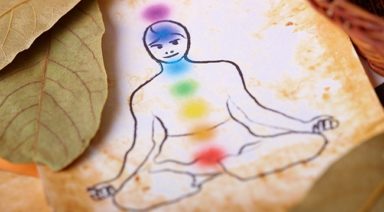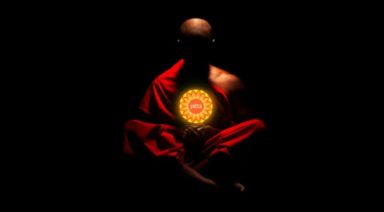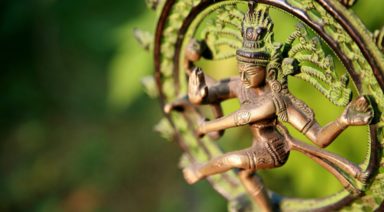Creating the Container for Kali: How the Goddess Shows Up in Your Life
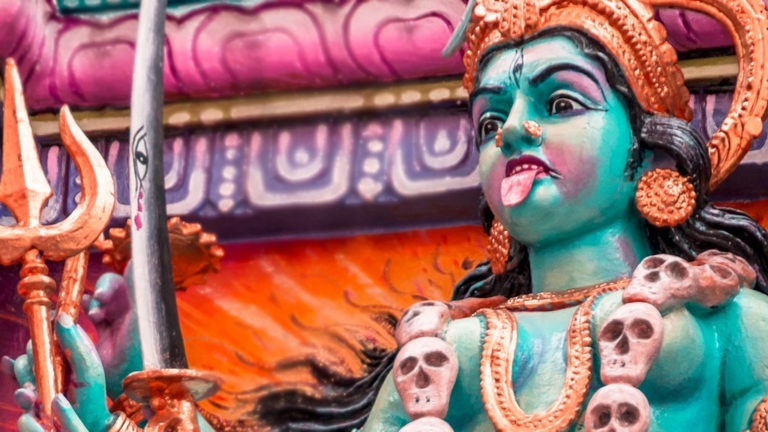
When I found her, Kali was waiting in the window of the Ma Shrine (a temple for female deities) at my new ashram home. I was mesmerized. She didn’t look anything like the other goddesses in the temple which was filled with examples of the feminine divine. All the other goddesses were wooden or metal, seated on a lotus or astride a peaceful looking mount. Even Durga carrying all her weapons and emanating powerful assurances sat calmly atop her tamed tiger.
In contrast, Kali was a smaller wooden statue painted in the brightest colors of the room. With jet black skin and the reddest tongue extended through her open mouth, reaching for me as if to swallow me whole, she wore a necklace of severed heads and a skirt of severed limbs.
She stood atop a resigned Shiva Lord of the Universe as a conqueror claims their prize. There was nothing peaceful about her! She was ferocious, and everything about her image should have been terrifying in my context of non-understanding. But I wasn’t afraid. I was drawn to her.
Kali was the first goddess I would ever have a relatable experience with from energetic understandings that lay beyond the perception of her form. I sat there and looked to her for what seemed like hours. Every day I would go to the Ma Shrine after our morning meditations and visit all the mother goddesses, offering Kali a flower and trying to feel what she was awakening in me: my power.
Years later, I became a mother myself. The day I became a mom, was the most beautiful experience of celebrating life and specifically that of my son, who is my everything. He is a constant source of inspiration for me still, just six and a half years along my journey into becoming a mother goddess. Love like this has no description you can place from pen to paper.
Asana Practices For Connecting With Kali
Kali is strength and perseverance. In asana practice, anytime you feel you just can’t hold a pose for one more breath or flow through a challenging sequence one more time you can visualize and feel her power flowing through you. Warrior poses, goddess pose, and lion’s breath can all be reminders of that inner resource that is our personal connection to Kali.
The ultimate experience of Kali on the mat happens at the end. When we roll from the pose of death, savasana, into the fetal position awaiting our rebirth. It’s Kali’s strength that frees us from what we have left behind on the mat. It’s Kali’s light that shines on the path forward.
Meditations on Kali
In meditation, we can cultivate the qualities we experience focusing on the representations of divinity and draw strength from their power. Meditating on Kali we remind ourselves that, “today I am strong.” I am the Ma. I can devour any darkness no matter how heavy and hard it may seem and bask in the light.
- Find an image or a statue of Kali that resonates with you. Remember, feeling a connection internally to her image doesn’t have to mean you understand it cognitively. You may also find her a little scary at first, but it’s exactly that journey through fear that she teaches us.
- Sit calmly in a quiet space and gaze at the image of Kali feeling the place in you that is harmonizing with her energy. From time to time, offer her a candle, a flower, some incense, or a sweet treat to develop a relationship with the goddess.
- Use Kali’s mantra to resonate on the same frequency as her power and feel your own inner resources grow strong. If you like, you can use a mala or prayer beads to say the mantras 108 times: Om krim kalikayai namah.
Inviting the Fierce Feminine Mother Kali Into Your Life
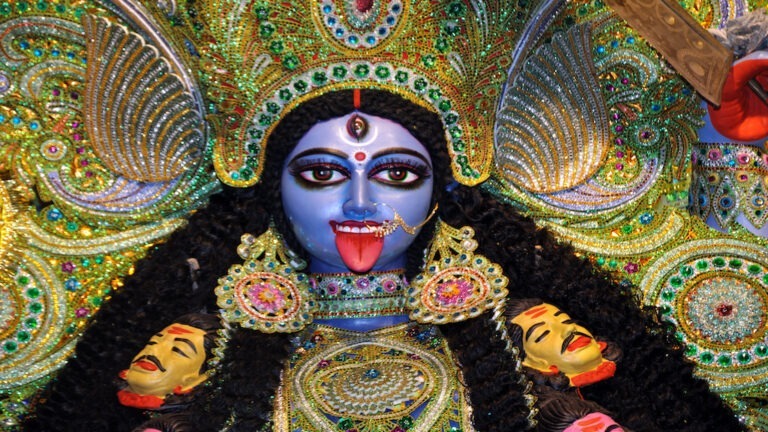
I am particularly fond of participating in or teaching classes themed around the Goddess Kali. Creating an invitation for Kali to enter our life is a way to invite fierceness into our being. She is the powerful and ferocious energy of the feminine mother.
Kali is often referred to in Hindu mythology as the dark goddess, the goddess of doomsday, the goddess of time, and the goddess of death. But once we delve deeper into what she really stands for, we see beyond this doomsday classification. She is ferociously powerful, and in her power, she is the fierce representation of motherly love; a mother’s bold and fiery force of love, as well as her innate desire to protect and support her children.
Kali is a form of Shakti or the feminine universal energy that motivates creativity and fertility. She is also an incarnation of Parvati, the Earth Mother (first wife of Shiva of the Holy Trinity). In this way, she also becomes a feminine counterpart to Lord Shiva, the God of Destruction. Her name has been translated as ‘she who is black’ or ‘she who is death.’
Many of the depictions of Kali show a warrior goddess to be feared. She is often seen wearing a necklace of chopped-off heads and a skirt of severed arms. She wields a knife dripping blood in one hand, holds a decapitated head in the other, and has a red lolling tongue dripping with blood.
As the goddess of time, Kali embodies the true nature of time. She demonstrates how time eventually absorbs all things. She is the ending to the beginnings and middles. Remember also that every ending holds a void of space, or nothingness, and from the space of nothingness, bright new beginnings are generated.

